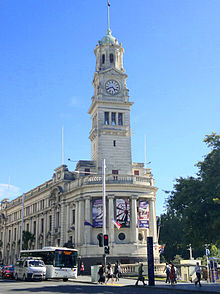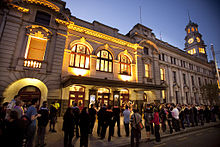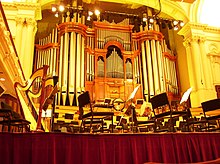Auckland Town Hall

The Auckland Town Hall is a historic building on Queen Street in the center of the New Zealand city of Auckland . It is used by the local administration for meetings and hearings as well as for events, and the building also houses a concert hall.
The Town Hall and its structural environment are particularly protected in the development plan of the city of Auckland as a "Category A" historical site. The owner is the Auckland Council . The New Zealand Historic Trust has listed it as a category 1 monument under number 549 since July 27, 1988.
history
The 45 meter high structure was built from 1909 to 1911 for £ 126,000 and inaugurated on December 14, 1911 by the then Governor of New Zealand , Lord Islington .
The design came from Melbourne- based architects JJ & EJ Clarke . The design in the style of the Italian Neo-Renaissance prevailed from a total of 46 designs. The five-story building is adapted to the wedge-shaped property between Queen Street and Gray Street. Outwardly it is strongly reminiscent of the new Lambeth Town Hall in the London Borough of Lambeth , which was built around the same time. The building was the permanent seat of local administration, but also served for entertainment purposes. The large hall with 1673 seats is designed after the old Gewandhaus in Leipzig and has excellent acoustics.
The facade is made of two different stones. The ground floor consists of dark basalt that was brought from Melbourne, Australia, despite the availability of basalt on site . The reason for this was possibly that the architects had previously obtained basalt of consistently high quality from the Australian quarries and that powerful steam-powered saws were available there for processing this difficult stone.
The upper floors are made of light-colored sandstone from Oamaru (Oamaru limstone) from the South Island, which characterizes the local appearance there.
Inside there are different types of mosaic floors and glaze wall tiles. The semicircular council chamber is clad with wooden panels. The main rooms have Art Nouveau style electric lighting and stained glass windows. The ceilings of the rooms on the representative floors are decorated with high quality stucco. It is particularly high quality in the large hall.
The clock on the four sides of the tower is a donation from MP and Mayor Arthur Myers . He had sponsored the building project before and during his tenure as mayor from 1905 to 1909. One of his last official acts as mayor was the laying of the foundation stone.
The interior of the Town Hall was restored from 1994 to 1997 for NZ $ 33 million, partly because the unreinforced masonry did not meet today's earthquake safety standards , especially as an event venue. Structural engineer Sinclair Knight Merz used innovative measures to reinforce the structure without changing the exterior too much.
Restoration work was also carried out on the facade in 2007. In the 1950s, a number of decorative elements were removed from the facade for fear of earthquake damage. Part of the Oamaru limestone had been damaged by aggressive cleaning methods. This was replaced by new limestone from the same rock layers from the original quarry in North Otago.
The acoustics in the concert hall have been improved by reducing previous attempts at improvement and replacing them with less conspicuous and more effective measures. The colors of the Edwardian original were chosen again for the color scheme of the interior of the building. Damaged porcelain and ceramic tiles in the foyer have been replaced with replicas. The original carpet was also replaced by a replica, only a remnant of the original carpet remained in one corner of the council chamber for illustrative purposes. The colored glass windows were restored and partly rebuilt, the building was modernized in terms of fire protection.
In February 2016, the administration of the Auckland Philharmonia Orchestra moved to the former office of the Mayor of Auckland.
organ
The organ of the Town Hall dates from 1911 and was designed by Henry Brett financed. It is the largest in New Zealand and a "protected object" under New Zealand law. It underwent major changes in 1969–1970 when the organ movement reached New Zealand. Large parts were broken off, others added in order to adapt the previously romantic sound to the then favored baroque sound .
This organ was dismantled in 2008 and rebuilt using parts of the original instrument from 1911 and new parts from Orgelbau Klais from Bonn .
The city of Auckland financed most of the restoration with NZ $ 3 million , with a further NZ $ half million from private donations. The organ was inaugurated on March 21, 2010 with a symphony commissioned for it.
Individual evidence
- ↑ a b Auckland Town Hall ( Memento of the original from June 10, 2007 in the Internet Archive ) Info: The archive link was automatically inserted and has not yet been checked. Please check the original and archive link according to the instructions and then remove this notice. on the Auckland City Council tourism website
- ↑ a b Auckland Town Hall ( Memento of the original from September 30, 2007 in the Internet Archive ) Info: The archive link was inserted automatically and has not yet been checked. Please check the original and archive link according to the instructions and then remove this notice. on The-edge.co.nz
- ↑ The Engineering Heritage of Auckland (dynamic link from the 'Heritage Walks' website of IPENZ )
- ^ New Zealand Herald: New Town Hall base for city's orchestra. In: New Zealand Herald. Retrieved April 19, 2016 .
- ^ Restored Auckland Town hall organ ready to sing . In: Auckland City Council (Ed.): CityScene . March 7, 2010, p. 1 (English).
- ^ Website of Klais Orgelbau for the organ, accessed November 14, 2012
Web links
Coordinates: 36 ° 51 ′ 9.7 ″ S , 174 ° 45 ′ 48.6 ″ O


